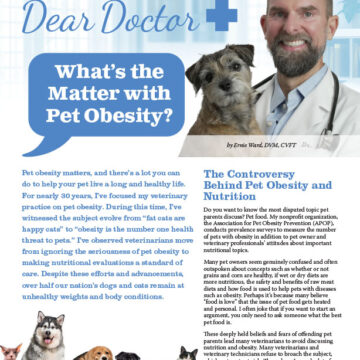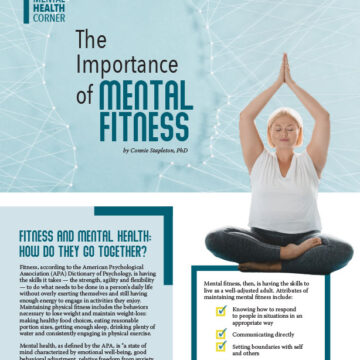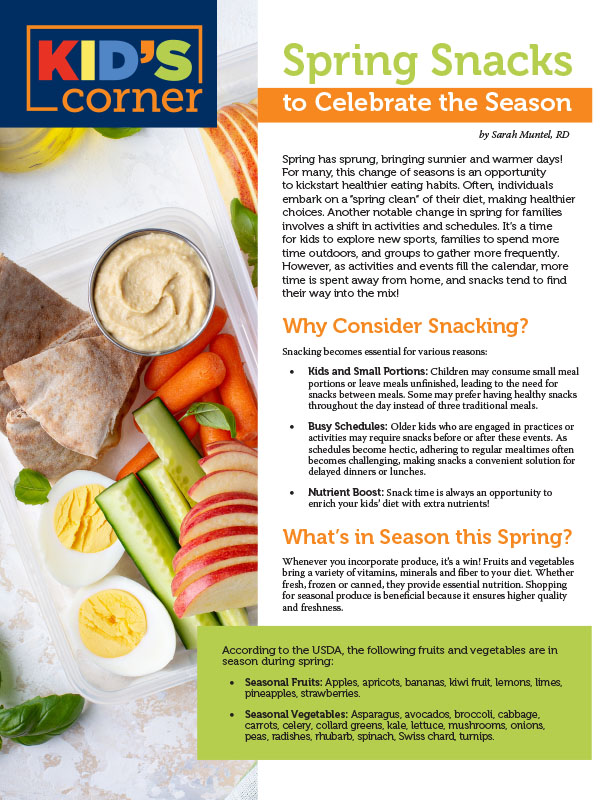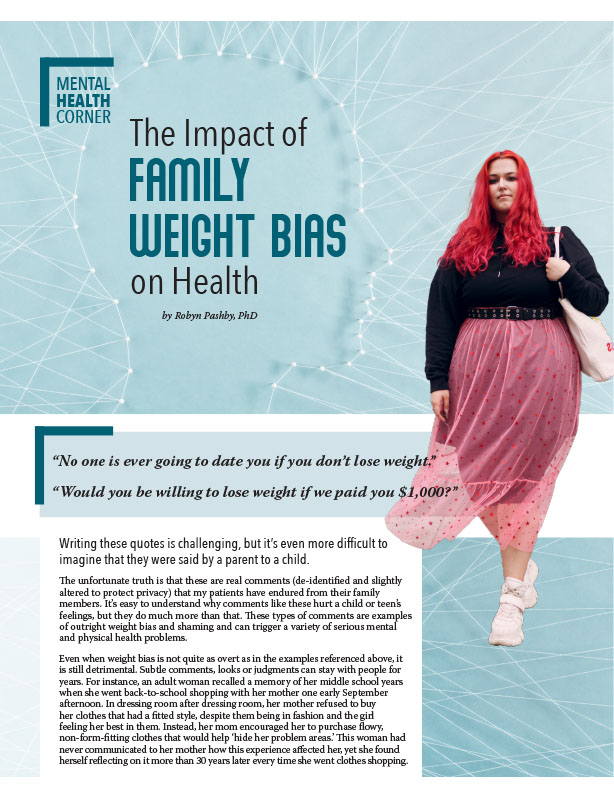Navigating Misleading Food Marketing

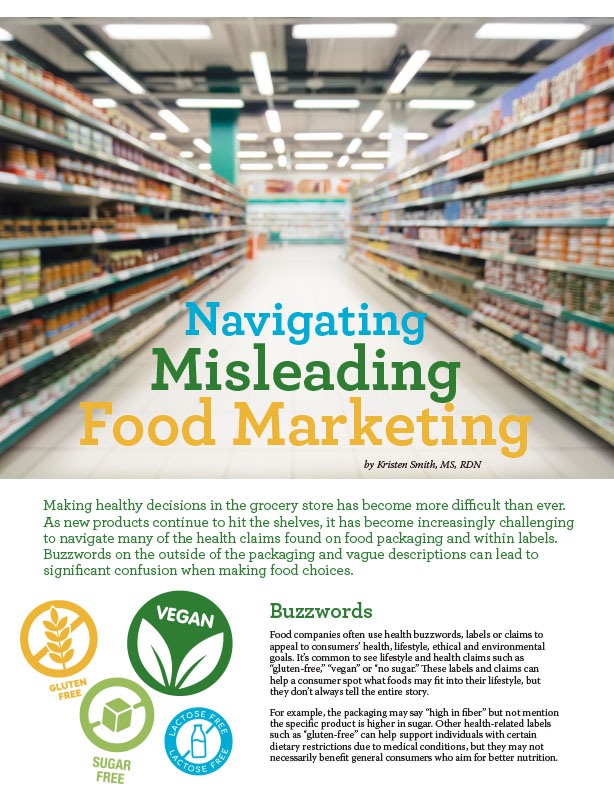
by Kristen Smith, MS, RDN
Spring 2023
Making healthy decisions in the grocery store has become more difficult than ever. As new products continue to hit the shelves, it has become increasingly challenging to navigate many of the health claims found on food packaging and within labels. Buzzwords on the outside of the packaging and vague descriptions can lead to significant confusion when making food choices.
Buzzwords
Food companies often use health buzzwords, labels or claims to appeal to consumers’ health, lifestyle, ethical and environmental goals. It’s common to see lifestyle and health claims such as “gluten-free,” “vegan” or “no sugar.” These labels and claims can help a consumer spot what foods may fit into their lifestyle, but they don’t always tell the entire story.
For example, the packaging may say “high in fiber” but not mention the specific product is higher in sugar. Other health-related labels such as “gluten-free” can help support individuals with certain dietary restrictions due to medical conditions, but they may not necessarily benefit general consumers who aim for better nutrition.
Packaging Color and Design
Packaging color and design also play a role in consumer food choices. Some marketing experts believe the color of the packaging may be indicative of health factors. For example, many think a green package may signify that the product is organic or vegetarian, while blue represents “calm” and “fresh.” Food package design plays a huge role in food choices for both parents and children. Children are often influenced by cartoon characters or other flashy graphics. However, it’s common for products with attractive packaging to lack health benefits.
Food product and packaging claims can influence consumers’ purchasing decisions as well as portion sizes. It’s common for consumers to skip reading the food label and use the marketing claims on the front of the packaging as their decision-making guide. If a consumer is trying to lose weight but desires a cookie, they are more inclined to choose something labeled “high fiber” or “oatmeal” without realizing the product could still contain high amounts of sugar and trans fats. They are also more likely to eat larger portions because they believe they are making a healthier choice. Regardless of what is on the outside or front of a package, you should still look over the food label.
The Importance of Reading the Label
While it’s easy to quickly glance at food packaging to make informed choices, don’t forget the importance of reading food labels. Knowing what to specifically look for when reading food labels and ingredient lists can make grocery shopping a lot quicker and less burdensome. You can quickly look at the label to determine how much fat, sugar and carbohydrates are in the product.
For example, if you’re trying to eat more fiber and a food package claims it’s a high-fiber product, turn the package over and make sure the label indicates at least three to five grams of fiber per serving. It’s also important to scope out the ingredient list to better understand all the ingredients within the product. Specifically, check out the first three to five ingredients that are listed. Product ingredients are listed by quantity from the highest to the lowest amounts. This means that the first ingredient is what the manufacturer used the most of.
Once you are aware of misleading food marketing and how packaging can get your attention, you should find it easier to navigate the grocery store and make choices that are consistent with your health goals. It may also help you to follow these tips and tricks with your children to minimize filling your cart with food items that lack nutritional value.
How to Better Understand Food Claims
Learn which food marketing phrases can help you stick to your health goals and which terms won’t be all that helpful.
- Natural: Products claiming to be “all natural” generally sound appealing. However, the package label might not indicate the product is naturally produced in the way you would expect it to be. According to the U.S. Food and Drug Administration (FDA), the label “natural” is meant to indicate that nothing artificial or manufactured has been added to the product. The policy does not include food production and manufacturing methods such as pesticide use or pasteurization.
- Processed: The labels “processed” and “unprocessed” are commonly confused. The term “processed food” doesn’t just refer to unhealthy packaged foods with lots of additives. Foods labeled as “processed” indicate the food has experienced some type of change from its original form. Most people don’t realize foods such as roasted nuts, cut and peeled fruit, and tofu are processed because they aren’t in their original form.
- Local: Many people prefer to purchase locally produced foods to promote environmental sustainability and help support the local economy. While it’s often thought that food bought closer to home is fresher and has little to no pesticides or additives, this isn’t always the case. There is no defined distance for what foods can be considered “local.”
- Whole Food: The label “whole food” typically indicates that a food has not been processed or refined and appears close to its original form. Most people label foods such as fresh produce, dairy, whole grains and meat as “whole foods.” No regulatory definition for “whole food” exists, however. Most foods considered to be “whole foods” are typically nutrient-dense and offer many health benefits.
- Wheat/Multigrain: Product packaging may claim “wheat” or “multigrain” but still not contain 100% whole wheat because it is made with enriched flour. To verify whether a product is made with whole grains, check out the ingredient list and choose something with at least three to five grams of fiber per serving.
- Gluten-free: The “gluten-free” dietary trend has increased in popularity over the past decade. Many people believe eating “gluten-free” foods will give them health benefits. Typically, only individuals with celiac disease or certain food allergies and intolerances will benefit from following a gluten-free diet. Some gluten-free products contain more calories and fat than their gluten-containing counterparts.
- Superfood: The term “superfood” may make a food appear to be healthier than other options. However, the term doesn’t really provide any helpful information. Currently, there is no definition of a “superfood.” Eating a variety of fruits, vegetables and whole grains helps us meet our nutritional needs. One “superfood” alone does not help us do this.
How to Manage Misleading Marketing With Your Children
Navigating the grocery store and maintaining your family’s health can be challenging with misleading and attractive food marketing. Here are some tips and tricks for managing a trip to the grocery store with your child.
- Spend the majority of your shopping time in the outer perimeter of the store or in areas where food packaging design is minimized (like beans, pasta or canned vegetables). Talk to your children about how foods not in packages or in plain packaging such as fresh fruits, vegetables and whole-grain pasta can be healthy for their bodies.
- Encourage your children to eat the rainbow. Referring to foods as a rainbow may help excite them about eating a variety of choices. Different fruits and vegetables provide different nutrients and have different flavors. Aim for diversity!
- Spend the bulk of your shopping time in areas where healthier products can be found. Most grocery stores group together healthier products, which tend to have fewer misleading claims, toward the end of an aisle or in a separate section.
- Allow your children to pick a few items at the grocery store. You can’t avoid all misleading packaged goods, but you can strive for balance. Teaching your children balance rather than avoidance at a young age can lay the foundation for a healthy eating pattern for years to come.
Conclusion
With misleading marketing, attractive packaging and the use of popular phrases like “gluten-free,” it can be difficult to sift through false food claims. If you’re able to, spend a little more time reading the ingredients and the labels on food products before settling on a specific food or brand.
About the Author:
Kristen Smith, MS, RDN, is a bariatric surgery program coordinator in Atlanta. She has been a practicing registered dietitian for nearly two decades and is a national spokesperson for the Academy of Nutrition and Dietetics. Kristen’s nutrition expertise has been featured in interviews on Good Morning America, The New York Times, WebMD, US News and much more.
by Sarah Muntel, RD Spring 2024 Spring has sprung, bringing sunnier and warmer days! For many, this…
Read Articleby Robyn Pashby, PhD Winter 2024 “No one is ever going to date you if you don’t…
Read Articleby Michelle “Shelly” Vicari Winter 2024 Winter has arrived! Don’t allow the chilly and damp weather to…
Read Article




